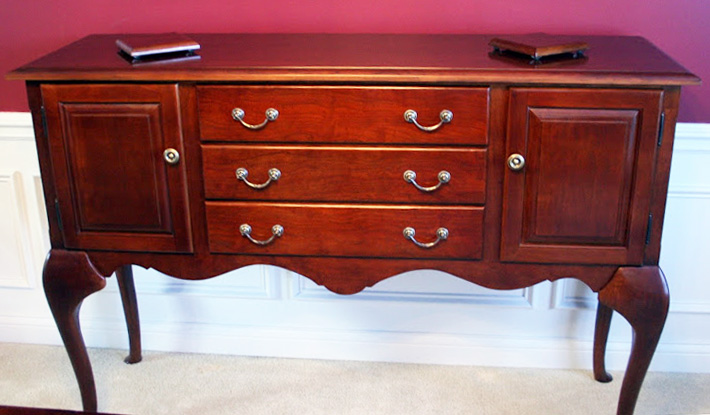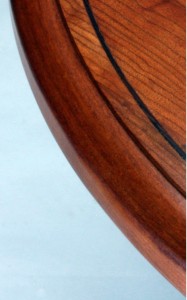Retired following a successful 30-year business career, Woodmaster Drum Sander owner, Keith Neer teaches woodworking to select students and accepts just four or five furniture commissions a year.
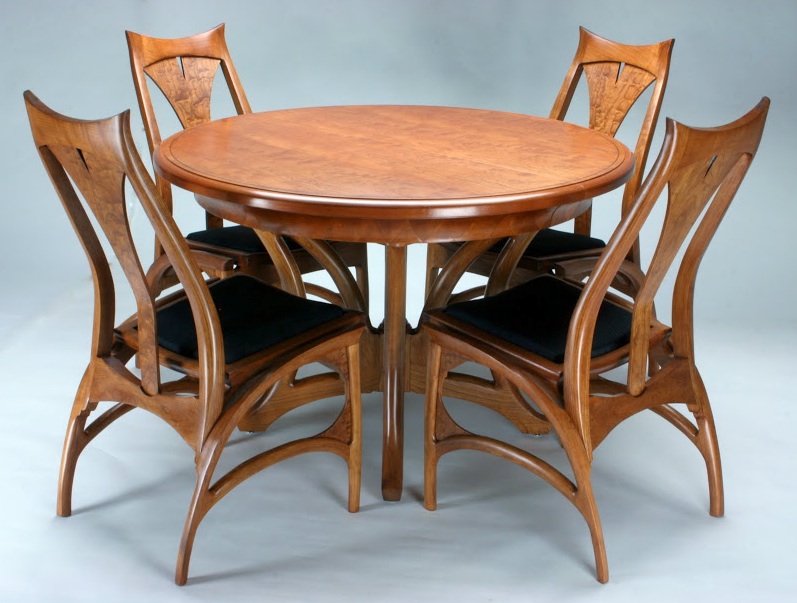
“While at the Marc Adams School of Woodworking, I was admitted into the Michael Fortune Fellowship Program. I made this one-of-a-kind table and chairs from bent laminations of quarter-sawn cherry. Following the bending process, all surfaces were sculpted to the shape you see in the photo.”
“43 years ago, I bought an old lathe and tools at a farm sale and proceeded to make some really ugly candleholders as Christmas presents. I’ve been working in wood ever since. About 15 years ago, I began taking professional woodworking classes. Then, about nine years ago, I retired. My wife said, ‘You’ve been talking about becoming a professional woodworker all your life, why not do something about it?’ And I made the move to doing woodworking full time. Not as a business, but as something I love to do.
I built a woodworking shop in an industrial park and planned to have students and do commissioned work. And that’s what I’ve done. In the past nine years, I’ve had 60 or 70 students. Some come with a project in mind. Some come to learn a skill. Some don’t stay long; others, six or eight years. Part of my motivation to teach is I want to spread the word about woodworking. I don’t get hundreds of students but I do try to share what I’ve learned. After all, very little of what I do is my own invention.
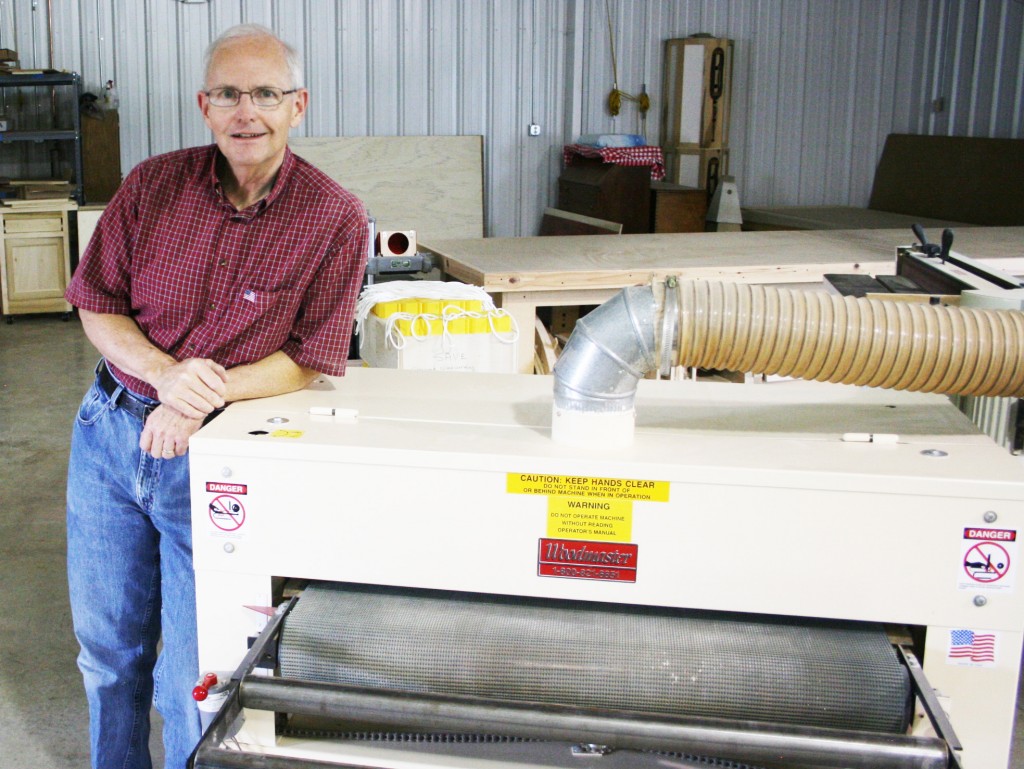
Keith Neer, master craftsman and Woodmaster Drum Sander owner, teaches woodworking and produces a limited number of furniture commissions for the pure love of woodworking. He told us recently, “I’m retired. I’m not in this to make money. It’s a pleasure to do woodworking the way I want to at the end of a 30-year career.”
SAVE BIG NOW on Woodmaster Drum Sanders! – sale prices, online specials
SAVE BIG NOW on Woodmaster Molder/Planers! – sale prices, online specials
Teaching takes about half my time; building commissioned work takes the other half. I make four or five major pieces of custom furniture a year, all one of a kind. I rarely make the same thing twice. It’s all by word of mouth.
Woodmaster’s precision sanding essential in Keith’s bent lamination process
I do a lot of work with bent lamination. When I make bent elements of furniture, I do it with lamination rather than steam bending. I need to be able to cut something with a bandsaw and be able to sand down to 1/32 of an inch thick without having the sander eat up the piece. There’s no way you can put a piece this thin through a planer.
Here’s how I do bent lamination. Look at the curved backs of the chairs on my home page and in this blog post. The thickness of the backs, front to back, tapers from about 1-1/2” thick at the bottom to about ¾” thick at the top. Each back is made of 26 glued-up wood strips. And though the thickness of the back varies from the top to bottom, each back has the same number of layers of wood strips from top to bottom. I cut 26 very thin strips of wood, each one tapered thinner at one end than the other. Because each strip is so thin, I can bend it to a curved form and glue it.
To control the taper, I built a jig that held the wood at the angle I wanted for each layer. I used that jig to cut tapered strips on the bandsaw. I used the same jig to guide each strip through the Woodmaster Drum Sander. Each strip is tapered a few thousandths of an inch from top to bottom. You can’t do it this way without the proper jigs and fixtures, or without the right equipment. A sander that can’t hold the tolerances the Woodmaster does would ruin the work I did when I sawed out the pieces on my bandsaw.
Accurate to .0015 (that’s 15 ten-thousandths!) across 38”
I was curious about how much “run-out” there was in the Woodmaster — how much difference in sanding depth between the two ends of the sanding drum. I was dumbfounded to find out the run-out was only .0015 (15 ten-thousandths) of an inch from one end to another! That’s .0015 difference across a 38” wide drum – that’s nothing in the woodworking business! To put it in simple terms, a United States dollar bill is .004 (four thousandths) thick. A dollar bill is three times thicker than the run-out in the Woodmaster!
Woodmaster’s simple, economical design is praiseworthy
A sander is a tool to be used with finesse to take off small amounts of wood with precision. Woodmaster does this at an affordable cost. It was exactly what I needed. As sanders go, the Woodmaster Drum Sander is very economical and has a very simple design. I say that as praise. Heavy industrial equipment like Powermatic® and General International® are heavier, more industrial type machinery and they’re very expensive.
My first Woodmaster Drum Sander was the 26” 2675. A student of mine fell in love with it and I sold it to him! I bought my second one, the 38” 3875, because I wanted to be able to sand wider pieces. The reason I chose Woodmaster is the simplicity of its design. Almost nothing can go wrong, and anything that does go wrong can easily be fixed.
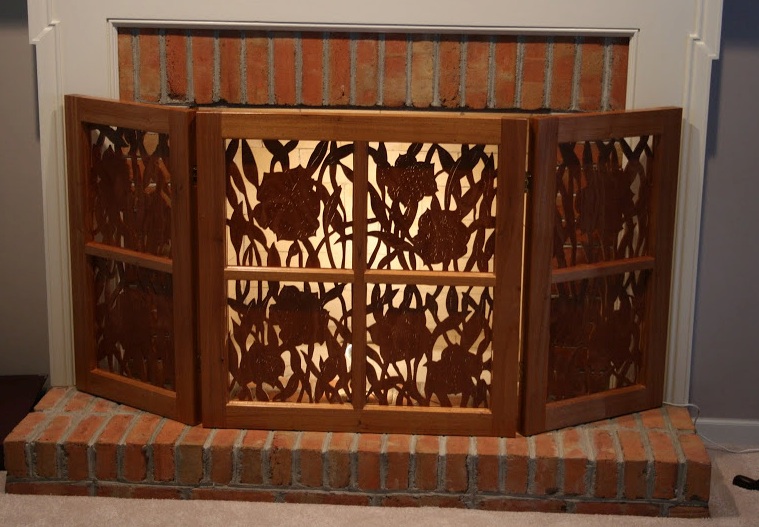
Here’s an outstanding Mahogany Fireplace Screen Keith made recently. Careful cutouts are silhouetted by the light behind t he screen.
Want a bargain? Go to Pottery Barn. Want an heirloom? Talk to Keith.
My plans for the future? More of what I’ve been doing. I have no intention to change; I’m having too much fun doing what I’m doing. As long as I can build four or five custom pieces a year, and as long as I have students, I’m happy.
Sometimes people come to me for custom work expecting a bargain because I’m retired. I tell them if they want a bargain, go to Pottery Barn or Ikea for a desk or bookcase or table. My goodness, go buy it with my blessing! I don’t do bookcases or kitchens. Bookcases aren’t any fun to build; cabinetry is great but it doesn’t float my boat and I’m in a position to pretty much do what I want.
I tell people if they want to make an heirloom, or if they want something special like a chair with a curved back, or they want inlay, talk to me because I can do that. My work is going to be different than anybody else’s. If that has value to you, then we can start a relationship.
I’m retired. I’m not in this to make money. It’s a pleasure to do this work the way I want to at the end of a 30-year career. I make enough money in woodworking to support my ‘woodworking habit’ and contribute to health care and vehicles. My ‘habit’ supports itself.”
— Keith Neer, Clermont Woodworking Craftsman, Woodmaster Drum Sander Owner
SAVE BIG NOW on Woodmaster Drum Sanders! – sale prices, online specials
SAVE BIG NOW on Woodmaster Molder/Planers! – sale prices, online specials
QUESTIONS? COMMENTS?
3 WAYS we can help you!
- Call us TOLL FREE 1-800-821-6651
• Email us info@woodmastertools.com
• Connect with us on Facebook

